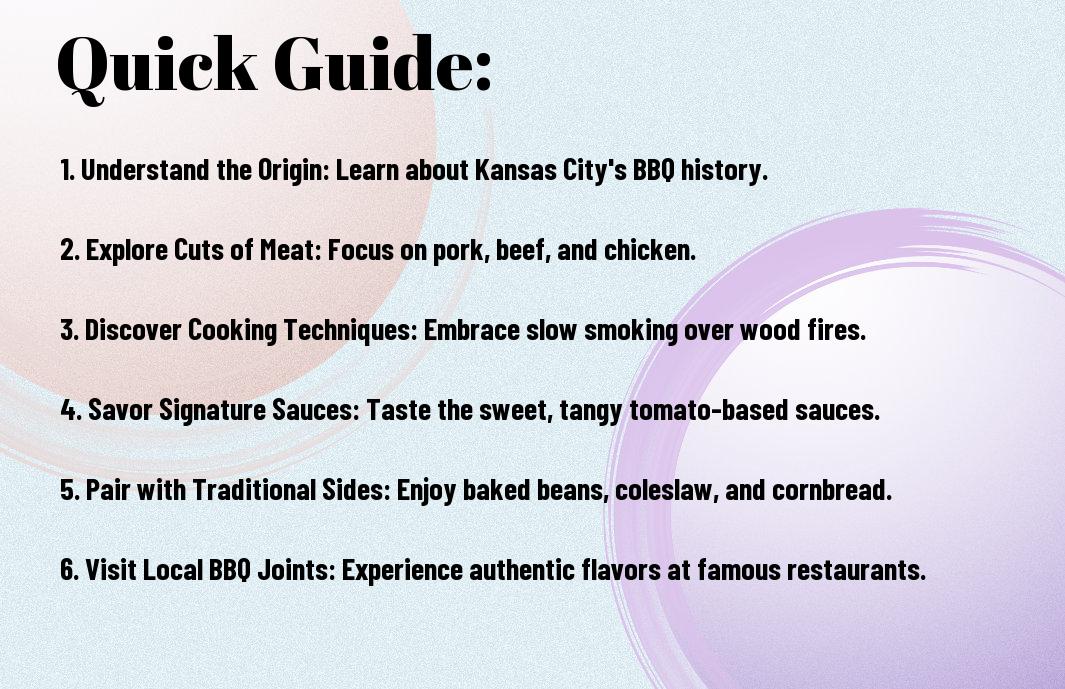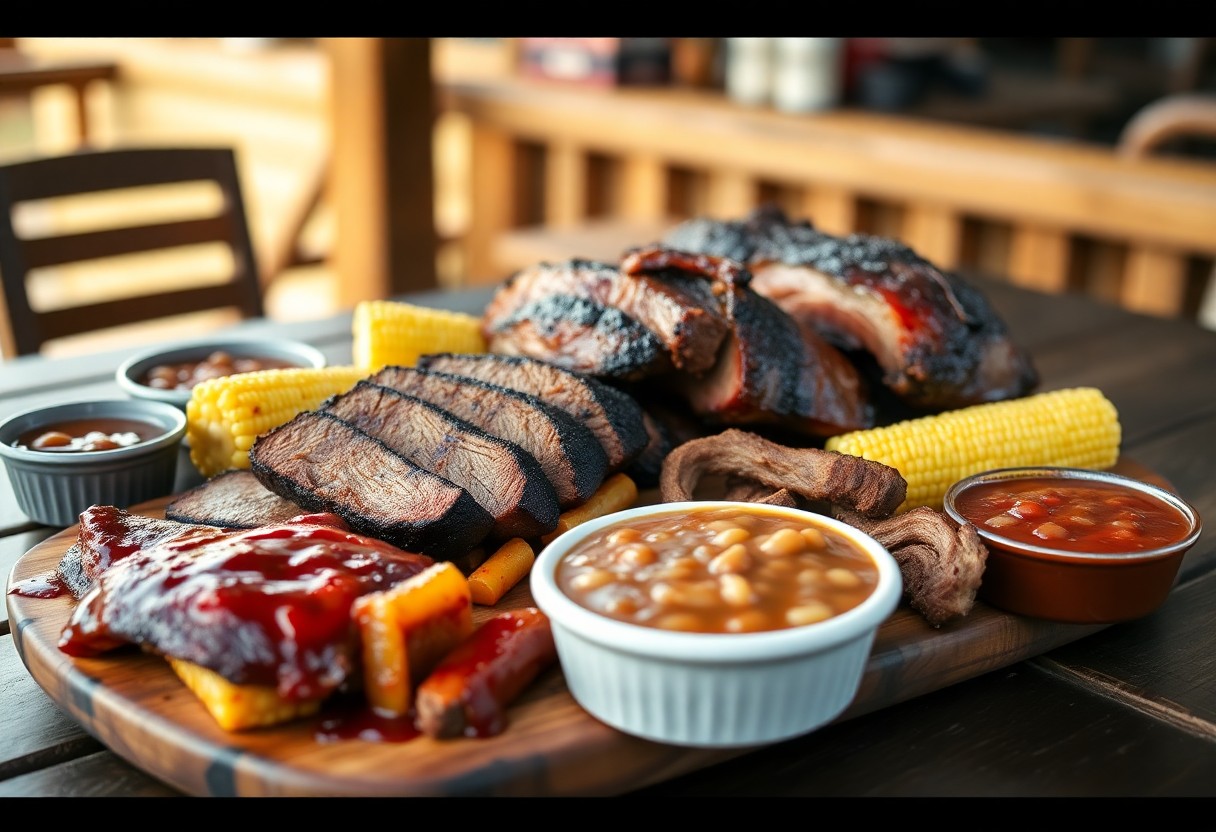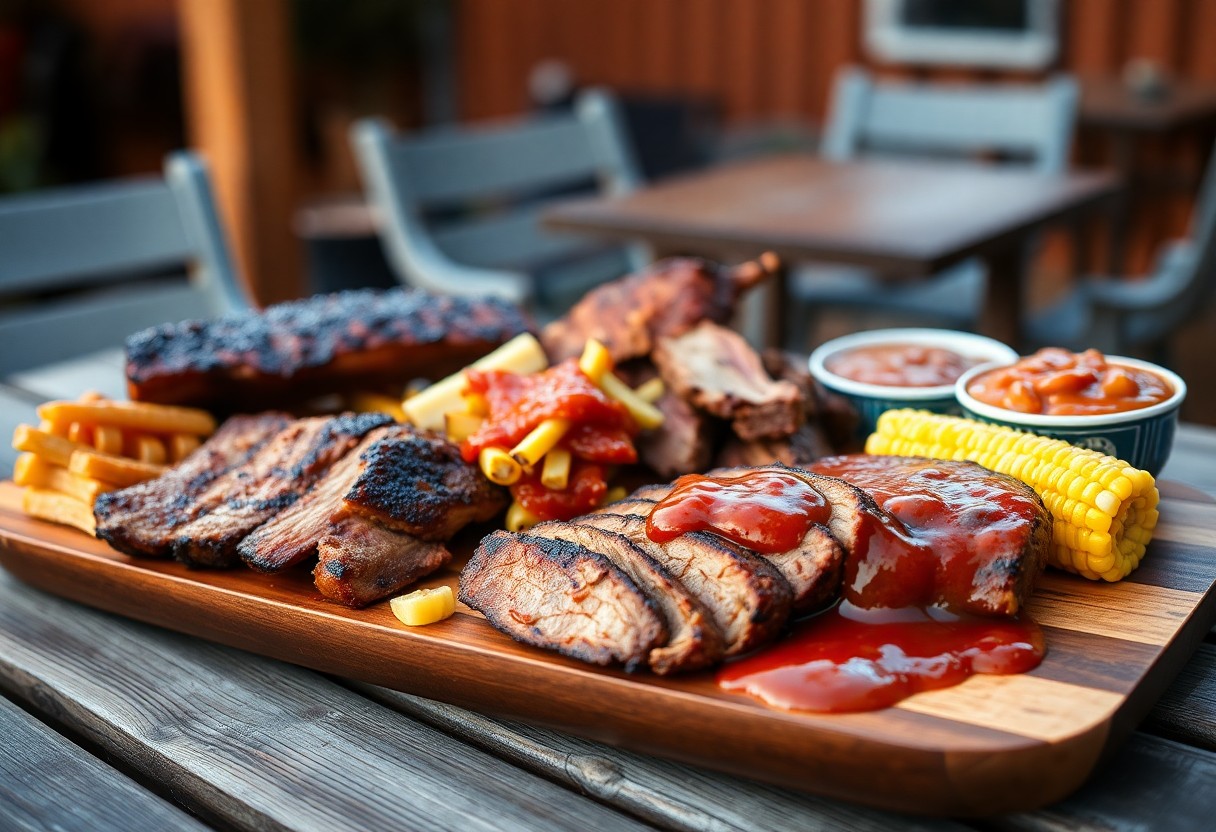Most BBQ enthusiasts consider Kansas City BBQ a must-try for its unique blend of flavors and cooking styles. In this guide, you’ll discover the rich history behind this iconic cuisine, learn about its signature meats, and understand how its famous thick, tomato-based sauces set it apart from other BBQ styles. Whether you’re a seasoned griller or simply a fan of good food, you’ll gain insights that will elevate your BBQ experience and bring the heart of Kansas City right to your palate.
Key Takeaways:
- Kansas City BBQ is characterized by a diverse variety of meats, including brisket, ribs, sausages, and chicken, often smoked to perfection using a mix of woods to enhance flavor.
- The use of a thick, tomato-based sauce distinguishes Kansas City BBQ, typically offering a balance of sweetness and tanginess, which complements the smoky flavor of the meat.
- Traditionally, Kansas City BBQ emphasizes a “low and slow” cooking method, which means meats are cooked at low temperatures for an extended period to achieve tenderness and a rich, smokey taste.

Types of Kansas City BBQ
Before plunging into the flavors, it’s imperative to understand the various types of Kansas City BBQ. This style is known for its variety, offering an array of meats and techniques that make it unique. Here’s a quick overview:
| Brisket | Slow-cooked and smoky, it’s a BBQ favorite. |
| Pork Ribs | Known for their tenderness and fall-off-the-bone goodness. |
| Pulled Pork | Shredded meat packed with flavor, often topped with sauce. |
| Sausages | Spicy or mild, offering a distinctive and hearty option. |
| Chicken | Grilled or smoked, often glazed with a tangy sauce. |
Any combination of these types will lead you to discover the satisfying world of Kansas City BBQ.
Meats Commonly Used
To fully appreciate Kansas City BBQ, you must know the meats commonly used. A variety of proteins grace your plate, including brisket, smoked pork ribs, pulled pork, chicken, and sausages. Each meat brings its own flavor and texture, contributing to the diverse BBQ experience that Kansas City is famous for.
Sauces and Seasonings
Assuming you are a fan of bold flavors, the sauces and seasonings of Kansas City BBQ will excite your palate. The hallmark of this BBQ style is its rich, tomato-based sauce that is sweet and tangy. Often enhanced with a variety of spices, this sauce becomes integral in enveloping your meats, offering depth and a punch of flavor.
With their combination of sweetness balanced by a hint of spiciness, Kansas City BBQ sauces are designed to complement, not overpower. The seasonings play a significant role as well, with blends of paprika, garlic powder, and black pepper that add to the layered flavors of your meat. You can even find innovative variations that showcase the creativity of local pitmasters. These elements together create an unforgettable dining experience that elevates your BBQ enjoyment.
Tips for Perfecting Kansas City BBQ
Even the most seasoned pitmasters can benefit from honing their skills. Here are some tips to ensure your Kansas City BBQ is mouthwatering:
- Start with quality meats.
- Use a balanced rub for flavor.
- Maintain a consistent temperature throughout cooking.
- Be patient; let your meats rest before serving.
- Experiment with different types of wood for smoking.
This will elevate your BBQ to a whole new level.
Selecting the Right Equipment
Right equipment can make or break your Kansas City BBQ experience. Investing in a good quality smoker is important, as it directly impacts the flavor and texture of your meats. Control of temperature is necessary; therefore, ensure your smoker has a reliable thermometer. Additionally, use sturdy grilling tools to flip and manage your food effortlessly. A well-stocked toolkit also includes meat thermometers and cutting boards. Don’t forget key items like sharpened knives for the perfect cut!
Understanding Cooking Techniques
Cooking techniques play a vital role in crafting that classic Kansas City BBQ flavor. You should explore methods like low-and-slow smoking, which benefits from indirect heat and allows flavors to develop gradually. Master the art of saucing, applying sweet, tangy sauces towards the end of cooking to caramelize the meats. Utilize methods like wrapping your meats during cooking to keep moisture in while enhancing tenderness. Finally, as you experiment, keep track of your findings for future BBQ sessions.
City BBQ style encourages exploration and innovation, but caution is necessary as well. Avoid rushing the cooking process; properly cooked meat should be juicy and tender. Always ensure to monitor your temperature closely, using reliable thermometers, to prevent undercooking or overcooking. By focusing on these important details, you enhance your BBQ’s texture and flavor profile while keeping safety in mind.
Step-by-Step Guide to Making Traditional BBQ
Not all BBQ methods yield the same flavor. Here’s a clear breakdown of the imperative steps you’ll need to master traditional Kansas City BBQ:
| Step | Description |
| Preparing the Meat | Season and marinate your meat to enhance flavor. |
| Smoking Process | Slow-cook the meat for the best results. |
| Finishing Touches | Add sauce and allow it to caramelize. |
Preparing the Meat
An imperative step in your BBQ journey is to select the right cuts of meat, such as brisket or pork ribs. You should then apply a dry rub consisting of spices like paprika, garlic powder, and brown sugar, letting it marinate for several hours or overnight to enhance its flavor profile.
Smoking Process
If you’re aiming for tender and flavorful BBQ, the smoking process cannot be rushed. Utilize a wood smoker and maintain a steady temperature of around 225°F. This low-and-slow approach will infuse the meat with that signature smokiness while preserving its moisture.
It is vital to choose the right type of wood, like hickory or pecan, as they impart unique flavors to your BBQ. Check the internal temperature regularly, ensuring it reaches a minimum of 190°F for ribs and 205°F for brisket. This technique allows the fat to break down, making the meat fall-off-the-bone tender.
Finishing Touches
If you want to elevate your BBQ experience, apply a flavorful sauce during the last 30 minutes of cooking. This will create a sweet and sticky glaze that enhances the overall taste of your meat.
For instance, you can choose a tangy tomato-based sauce or go for a sweeter variant, adapting to your personal preference. Be careful not to apply the sauce too early, as this can cause it to burn and lose its flavor. Instead, applying it toward the end allows you to achieve that perfect caramelized finish that defines traditional Kansas City BBQ.

Factors Influencing BBQ Flavor
Now, understanding the various elements that contribute to the unique flavor of traditional Kansas City BBQ is imperative for every enthusiast. Key factors include:
- Meat cut
- Cooking time
- Seasoning
- Wood smoking
- Temperature control
This combination creates a flavor-packed experience that defines Kansas City BBQ.
Wood Types and Their Impact
Now, the type of wood you use is vital in shaping the flavors of your BBQ. Different woods impart distinct characteristics, such as:
- Hickory
- Oak
- Pecan
- Mesquite
- Fruit woods
Recognizing the impact of wood types allows you to elevate your BBQ game significantly.
| Wood Type | Flavor Profile |
| Hickory | Strong, smoky flavor |
| Oak | Mild and versatile |
| Pecan | Nutty and sweet |
| Mesquite | Bold and intense |
| Fruit woods | Delicate and fruity |
Marinades and Brining Techniques
An imperative aspect of achieving mouthwatering BBQ is utilizing effective marinades and brining techniques. These processes allow you to infuse your meat with flavor and moisture. Key points include:
- Marinades improve flavor
- Brining enhances juiciness
- Timing is important
- Salt content matters
- Acidity adds tenderness
It is imperative to balance your marinade’s ingredients, ensuring you don’t overwhelm your meat’s natural flavor. You will want to pay particular attention to the salt content and make sure the marinade does not sit too long, as prolonged exposure can lead to over-salting. Additionally, incorporating ingredients such as citrus juice or vinegar enhances tenderness while preventing dryness during cooking. A great marinade balances flavor enhancers and maintains your meat’s integrity, giving you a rave-worthy BBQ experience.
Pros and Cons of Kansas City BBQ
After exploring the rich flavors of Kansas City BBQ, it’s important to weigh its advantages and disadvantages. Below, you’ll find a summary of what makes this style of barbecue a beloved favorite, as well as some aspects that might give you pause.
| Pros | Cons |
|---|---|
| Rich, smoky flavor | High calorie content |
| Diverse meat options | Can be time-consuming to prepare |
| Unique sauce varieties | Requires skill to master |
| Tradition and history | Potential for over-seasoning |
| Great for gatherings | Can be expensive for high-quality meat |
Advantages of Traditional Methods
City chefs pride themselves on using traditional methods, which foster a deeper connection to the art of BBQ. These techniques often incorporate wood smoking, allowing flavors to penetrate the meat beautifully. The results are rewards for your patience, as you experience layered textures and tastes. Additionally, these methods celebrate the regional heritage, giving you a taste of Kansas City’s unique culinary identity.
Potential Drawbacks
Clearly, while Kansas City BBQ is a delightful experience, it does come with some potential drawbacks. You should consider that the caloric density of traditional BBQ can be significant, which may not align with your dietary goals. Additionally, mastering these cooking techniques can require dedicated time and practice, possibly deterring beginners. Lastly, sourcing quality meats and ingredients can sometimes lead to higher costs, impacting your budget.
Cons of Kansas City BBQ include the hefty calorie counts, which might not be suitable for those watching their intake. Furthermore, the complexity of the traditional techniques can lead to frustration for those inexperienced in cooking or smoking meats, making the process feel like a chore rather than an enjoyable activity. If you choose to over-season or mismanage the cooking, it could result in less-than-optimal flavors. Finally, the cost associated with premium cuts of meat can impact your total expenses, making it a pricey affair for a casual meal.

Regional Variations and Influences
Many factors contribute to the unique flavors of Traditional Kansas City BBQ, including local ingredients and cooking techniques. You’ll find influences from Southern, Eastern, and Western BBQ styles, resulting in a distinctive blend of sweet, tangy, and smoky flavors. Kansas City is known for its diverse cultural heritage, which showcases its BBQ as a melting pot of regional influences.
Comparisons with Other BBQ Styles
Regional BBQ styles differ significantly across the United States. Here’s a quick comparison to help you understand what sets Kansas City BBQ apart:
BBQ Style Comparisons| Kansas City | Sweet and tangy sauce, diverse meats, smoked low and slow |
| Texas | Focus on beef, dry rubs, less reliance on sauce |
| Carolina | Pork-centered, vinegar-based sauces, regional variations |
| Memphis | Rib-focused, often dry-rubbed, served with a side of sauce |
Cultural Significance
An necessary aspect of Kansas City BBQ is its cultural significance. You’ll find that BBQ gatherings often serve as an opportunity for community bonding, celebrating traditions, and sharing stories. BBQ events and competitions in the area foster a sense of unity, showcasing the craftsmanship and passion behind each dish.
Plus, the local BBQ scene has provided economic growth and opportunities for many restaurateurs and chefs. Participating in BBQ culture allows you to connect with local history and engage with your community. This friendly competition encourages a sense of pride, making it more than just a meal but a vital aspect of Kansas City’s identity.
To wrap up
Upon reflecting on what makes traditional Kansas City BBQ unique, you can appreciate the rich flavors and techniques that define this culinary treasure. By understanding the significance of slow-smoking meats, the iconic use of a tomato-based sauce, and the variety of meats used, you can elevate your BBQ experience. Whether you’re hosting a backyard gathering or exploring local BBQ joints, your newfound insights will deepen your appreciation for this vibrant food culture. Enjoying Kansas City BBQ is not just about flavor; it’s about embracing a tradition steeped in history and community.
FAQ
Q: What distinguishes Traditional Kansas City BBQ from other BBQ styles?
A: Traditional Kansas City BBQ is known for its unique blend of flavors and cooking techniques. The style features a wide variety of meats, including beef, pork, chicken, and even turkey, all slow-cooked over a smoke-infused hardwood fire, typically using oak, hickory, or pecan. One of the key characteristics is the thick, sweet, and tangy tomato-based sauce that is often applied both during and after cooking. This versatility and robust sauce set it apart from other regional BBQ styles, such as Texas brisket or Carolina pulled pork.
Q: What types of meats are commonly used in Kansas City BBQ?
A: Kansas City BBQ is famously diverse when it comes to meat selection. Some of the most popular options include pork ribs (both baby back and St. Louis-style), sliced brisket, pulled pork, smoked chicken, and burnt ends (the flavorful, crispy ends of a smoked brisket). Additionally, some BBQ joints may even serve smoked sausage and whole smoked turkeys, catering to a variety of tastes and preferences.
Q: Is there a specific cooking method employed in Traditional Kansas City BBQ?
A: Yes, Traditional Kansas City BBQ primarily employs the low and slow method of cooking, where meats are smoked at low temperatures (typically between 225°F to 275°F) for several hours. This slow cooking allows the flavors to develop deeply while ensuring that the meats remain tender and juicy. The use of wood chips or logs for smoking adds a rich, smoky flavor that is characteristic of Kansas City BBQ, enhancing the overall taste experience.
Q: What role does sauce play in Kansas City BBQ?
A: Sauce plays a significant role in Kansas City BBQ, often being a defining feature of the style. The sauce is typically thick, sweet, and zesty, made from a tomato base and often seasoned with molasses, brown sugar, vinegar, and a variety of spices. It complements the meat rather than overpowering it, and is commonly slathered on during cooking to create a rich glaze while also being served on the side for dipping. This emphasis on sauce is part of what gives Kansas City BBQ its signature flavor profile.
Q: Are there any popular side dishes that typically accompany Kansas City BBQ?
A: Yes, traditional Kansas City BBQ is often served with a variety of beloved side dishes. Common accompaniments include coleslaw, baked beans, potato salad, cornbread, and pickles. These sides provide a balance to the smoky, rich flavors of the BBQ and add contrast in texture and taste. Many BBQ restaurants have their own signature sides, further enhancing the overall dining experience when enjoying Kansas City BBQ.
